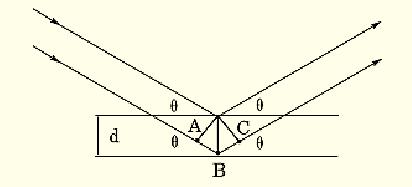


 النبات
النبات
 الحيوان
الحيوان
 الأحياء المجهرية
الأحياء المجهرية
 علم الأمراض
علم الأمراض
 التقانة الإحيائية
التقانة الإحيائية
 التقنية الحيوية المكروبية
التقنية الحيوية المكروبية
 التقنية الحياتية النانوية
التقنية الحياتية النانوية
 علم الأجنة
علم الأجنة
 الأحياء الجزيئي
الأحياء الجزيئي
 علم وظائف الأعضاء
علم وظائف الأعضاء
 الغدد
الغدد
 المضادات الحيوية
المضادات الحيوية|
Read More
Date: 20-4-2021
Date: 24-5-2021
Date: 30-11-2015
|
Bragg Angle
The Bragg angle is important for analyzing the diffraction from crystals in X-ray crystallography. W.L. Bragg noted that X-ray diffraction by a crystal can be understood without going into the details of diffraction theory (1). The process is similar to ordinary reflection of light from a mirror. In the crystal, the mirrors are the lattice planes. They are the planes constructed through the lattice points, which are the corners of the unit cells. Within a set, the planes are parallel and equidistant with perpendicular distance d (Fig. 1). q, the reflective angle, is called the Bragg angle. The beams reflected from the upper and the lower lattice plane are in phase and reinforce each other if the difference in path lengths of the two beams, which is given by the path A–B–C, is an integral number of the wavelength l. The path difference is also equal to 2d sin q. This results in Bragg's law: 2d sin q = n l, where n is an integer, 1, 2 3, etc.

Figure 1. Bragg's view on X-ray diffraction. The incident beam is reflected by lattice planes. d is their distance, and q is the reflective angle.
References
1. W. L. Bragg (1913) Proc. Cambridge Phil.Soc. 17, 43–57.



|
|
|
|
التوتر والسرطان.. علماء يحذرون من "صلة خطيرة"
|
|
|
|
|
|
|
مرآة السيارة: مدى دقة عكسها للصورة الصحيحة
|
|
|
|
|
|
|
نحو شراكة وطنية متكاملة.. الأمين العام للعتبة الحسينية يبحث مع وكيل وزارة الخارجية آفاق التعاون المؤسسي
|
|
|